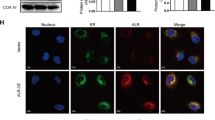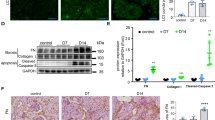Abstract
Background
Endoplasmic reticulum (ER) stress has been implicated in the development of various renal diseases. Thus, inhibition of ER stress using pharmacological agents may serve as a promising therapeutic approach. We postulated that febuxostat, a novel xanthine oxidase inhibitor, could suppress the ER stress through upregulation of SIRT1 (silent mating type information regulation 2 homolog 1)-AMPK (AMP activated protein kinase)-HO-1 (heme oxygenase-1)/thioredoxin expression.
Methods
We examined the effect of febuxostat on the ER stress induced by a chemical inducer, tunicamycin and non-chemical agents such as angiotensin II, aldosterone, high glucose, and albumin in renal tubular cells. We further examined the in vivo effects of febuxostat using mouse model of kidney disease induced by unilateral ureteral obstruction (UUO). Expression of ER stress was measured by western blot analysis and immunohistochemical stain.
Results
Febuxostat suppressed the ER stress induced by tunicamycin and non-chemical agents, as shown by inhibition of increased GRP78 (glucose-related protein78) and p-eIF2α (phosphospecific-eukaryotic translation initiation factor 2α) expression. Inhibitory effect of febuxostat was mediated through upregulation of SIRT1-AMPK followed by induction of HO-1 and thioredoxin. In animal model of UUO, febuxostat reduced the UUO-induced ER stress, which was abolished by pretreatment with SIRT1 inhibitor (sirtinol) and AMPK inhibitor (compound C).
Conclusion
Febuxostat could suppress the ER stress caused by various ER stress inducers through upregulation of SIRT1-AMPK-HO-1/thioredoxin expression. Targeting these pathways might serve as one of the possible therapeutic approaches in kidney diseases under excessive ER stress.









Similar content being viewed by others
References
Cybulsky AV. Endoplasmic reticulum stress in proteinuric kidney disease. Kidney Int. 2010;77:7–193.
Tanjore H, Lawson WE, Blackwell TS. Endoplasmic reticulum stress as a pro-fibrotic stimulus. Biochim Biophys Acta. 2013;1832(7):940–7.
Cybulsky AV. Endoplasmic reticulum stress, the unfolded protein response and autophagy in kidney diseases. Nat Rev Nephrol. 2017;13(11):681–96.
Julee PS, Deepa RP, Dhrubo JS. Febuxostat: the new generation novel xanthine oxidase inhibitors. Int Pharm Sci. 2011;1:107–15.
Sanchez-Lozada LG, Tapia E, Soto V, et al. Effect of febuxostat on the progression of renal disease in 5/6 nephrectomy rats with and without hyperuricemia. Nephron Physiol. 2008;108:69–788.
Tsuda H, Kawada N, Kaimori JY, et al. Febuxostat suppressed renal ischemia-reperfusion injury via reduced oxidative stress. Biochem Biophys Res Commun. 2012;427:266–72.
Omori H, Kawada N, Inoue K, et al. Use of xanthine oxidase inhibitor febuxostat inhibits renal interstitial inflammation and fibrosis in unilateral ureteral obstructive nephropathy. Clin Exp Nephrol. 2012;16:549–56.
Kim HS, Lim SW, Jin L, Jin J, Chung BH, Yang CW. The protective effect of febuxostat on chronic tacrolimus induced nephrotoxicity in rats. Nephron. 2017;135(1):61–71.
Kitada M, Kume S, Koya D. Role of sirtuins in kidney disease. Curr Opin Nephrol Hypertens. 2014;23(1):75–9.
Fisslhaler B, Fleming I. Activation and signaling by the AMP-activated protein kinase in endothelial cells. Circ Res. 2009;105:114–27.
Lee MJ, Feliers D, Mariappan MM, et al. A role for AMP-activated protein kinase in diabetes-induced renal hypertrophy. Am J Physiol Ren Physiol. 2007;292(2):F617–27.
Morales AI, Detaille D, Prieto M, et al. Metformin prevents experimental gentamycin-induced nephropathy by a mitochondria-dependent pathway. Kidney Int. 2010;77(10):861–9.
Takiar V, Nishio S, Seo-Mayer P, et al. Activating AMP-activated protein kinase (AMPK) slows renal cystogenesis. Proc Natl Acad Sci USA. 2011;108(6):2462–7.
Kirkby KA, Adin CA. Products of heme oxygenase and their potential therapeutic applications. Am J Physiol Ren Physiol. 2006;290:F563–71.
Yamawaki H, Haendeler J, Berk BC. Thioredoxin: a key regulator of cardiovascular homeostasis. Circ Res. 2003;93(11):1029–33.
Chung J, Shin DY, Zheng M, et al. Carbon monoxide, a reaction product of heme oxygenase-1, suppresses the expression of C-reactive protein by endoplasmic reticulum stress through modulation of the unfolded protein response. Mol Immunol. 2011;48(15–16):1793–9.
Kim Y, Li E, Park S. Insulin-like growth factor-1 inhibits 6-hydroxydopamine-mediated endoplasmic reticulum stress-induced apoptosis via regulation of heme oxygenase-1 and Nrf2 expression in PC12 cells. Int J Neurosci. 2012;122(11):641–9.
Ryan MJ, Johnson G, Kirk J, Fuerstenberg SM, Zager RA, Torok-Storb B. HK-2: an immortalized proximal tubule epithelial cell line from normal adult human kidney. Kidney Int. 1994;45(1):48–57.
Kim H, Moon SY, Kim JS, et al. Activation of AMP-activated protein kinase inhibits ER stress and renal fibrosis. Am J Physiol Ren Physiol. 2015;308(3):F226–36.
Pimentel JL Jr, Sundell CL, Wang S, Kopp JB, Montero A, Martinez-Maldonado M. Role of angiotensin II in the expression and regulation of transforming growth factor-beta in obstructive nephropathy. Kidney Int. 1995;48(4):1233–46.
Trachtman H, Weiser AC, Valderrama E, Morgado M, Palmer LS. Prevention of renal fibrosis by spironolactone in mice withy complete unilateral ureteral obstruction. J Urol. 2004;172(4 Pt 2):1590–4.
He L, Fan Y, Xiao W, et al. Febuxostat attenuates ER stress mediated kidney injury in a rat model of hyperuricemic nephropathy. Oncotarget. 2017;8(67):111295–308.
Hao CM, Haase VH. Sirtuins and their relevance to the kidney. J Am Soc Nephrol. 2010;21(10):1620–7.
Lee EK, Jeong JU, Chang JW, et al. Activation of AMP-activated protein kinase inhibits albumin-induced endoplasmic reticulum stress and apoptosis through inhibition of reactive oxygen species. Nephron Exp Nephrol. 2012;121:e38–48.
Thériault JR, Palmer HJ, Pittman DD. Inhibition of the unfolded protein response by metformin in renal proximal tubular epithelial cells. Biochem Biophys Res Commun. 2011;409(3):500–5.
Ruderman NB, Xu XJ, Nelson L, et al. AMPK and SIRT1: a long-standing partnership? Am J Physiol Endocrinol Metab. 2010;298(4):E51–60.
Lan F, Cacicedo JM, Ruderman N, Ido Y. SIRT1 modulation of the acetylation status, cytosolic localization, and activity of LKB1. Possible role in AMP-activated protein kinase activation. J Biol Chem. 2008;283(41):27628–35.
Sato Y, Feig DI, Stack AG, et al. The case for uric acid-lowering treatment in patients with hyperuricemia and CKD. Nat Rev Nephrol. 2019. https://doi.org/10.1038/s41581-019-0174-z.
Acknowledgements
Reprints request to Sang Koo Lee M.D., Division of Nephrology, Department of Internal Medicine, Asan Medical Center, 88, Olympic-ro 43-gil, Songpa-gu, Seoul 138-736, Korea. E-mail: sklee2@amc.seoul.kr.
Funding
No funding received.
Author information
Authors and Affiliations
Corresponding author
Ethics declarations
Conflict of interest
All the authors have declared no competing interest.
Ethical approval
All procedures performed in animal experiments were approved by Institutional Animal Care and Use Committee of Asan Institute for Life Sciences (Subject No: 2017-13-039).
Additional information
Publisher's Note
Springer Nature remains neutral with regard to jurisdictional claims in published maps and institutional affiliations.
About this article
Cite this article
Kim, H., Baek, C.H., Chang, J.W. et al. Febuxostat, a novel inhibitor of xanthine oxidase, reduces ER stress through upregulation of SIRT1-AMPK-HO-1/thioredoxin expression. Clin Exp Nephrol 24, 205–215 (2020). https://doi.org/10.1007/s10157-019-01804-8
Received:
Accepted:
Published:
Issue Date:
DOI: https://doi.org/10.1007/s10157-019-01804-8




